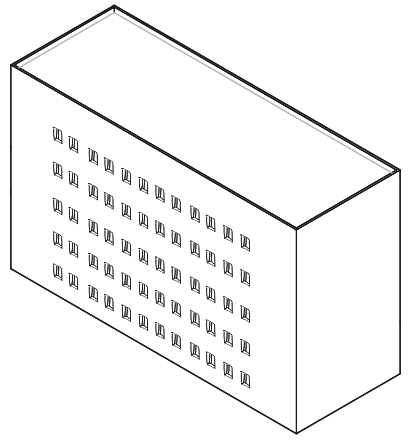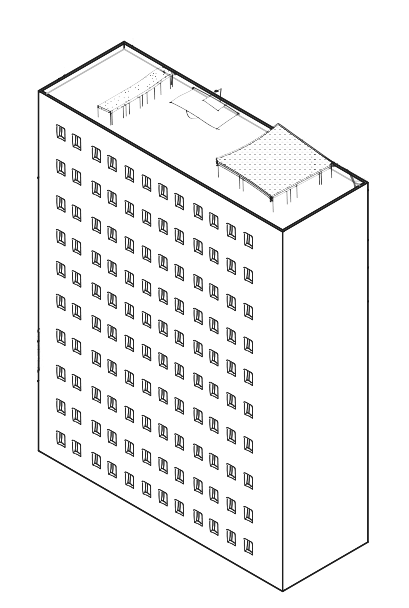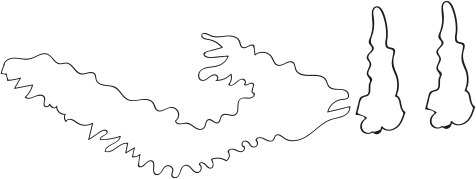Eastern Block Stories
9 - 25/01/2021, Haus Der Statistik
Visualising Large Housing Estates from Post Socialist Cities

Currently, up to 50% of urban residents in the post-socialist countries live in large housing estates or Microrayons, which were often built on empty territories in the urban periphery of the socialist cities.
A Microrayon or micro-district was a basic planning unit in the Soviet period that consisted of residential housing blocks for 5,000 to 10,000 inhabitants, providing necessary amenities like kindergartens, schools, health care, grocery shops and a few public facilities like a cinema or library.
Between 1956 and 1991, in Russia alone (RSFSR) almost 17 million apartments were built within large housing estates. In the mid-1980s about two thirds of the population in the former Soviet Union lived in cities, 85% of them in large housing estates.
In the frames of the educational project ACT|UP (“Activating Urban Periphery in Eastern Europe”) together with our partners from Georgia, Belarus, Russia, Ukraine and Poland we have learned many interesting facts about these large housing estates and gathered rich visual material from various countries. The Exhibition reflects on the different examples of Microrayons in various cities from Belarus, Russia, Ukraine, Poland, Serbia, Georgia to name a few, representing an outstanding way of showing the urban context of the so called Microrayons and telling the contemporary story of large housing estates in post-socialist Europe and beyond.
The exhibition is a result of more than one year’s work and is one of many efforts of the ACT|UP project to make the burning issues of postsocialist housing estates public, to spark a long overdue discussion and to exchange knowledge internationally.
A Microrayon or micro-district was a basic planning unit in the Soviet period that consisted of residential housing blocks for 5,000 to 10,000 inhabitants, providing necessary amenities like kindergartens, schools, health care, grocery shops and a few public facilities like a cinema or library.
Between 1956 and 1991, in Russia alone (RSFSR) almost 17 million apartments were built within large housing estates. In the mid-1980s about two thirds of the population in the former Soviet Union lived in cities, 85% of them in large housing estates.
In the frames of the educational project ACT|UP (“Activating Urban Periphery in Eastern Europe”) together with our partners from Georgia, Belarus, Russia, Ukraine and Poland we have learned many interesting facts about these large housing estates and gathered rich visual material from various countries. The Exhibition reflects on the different examples of Microrayons in various cities from Belarus, Russia, Ukraine, Poland, Serbia, Georgia to name a few, representing an outstanding way of showing the urban context of the so called Microrayons and telling the contemporary story of large housing estates in post-socialist Europe and beyond.
The exhibition is a result of more than one year’s work and is one of many efforts of the ACT|UP project to make the burning issues of postsocialist housing estates public, to spark a long overdue discussion and to exchange knowledge internationally.







Utopia
and
Ideology







Starting from the 1950s the construction of large housing estates or Microrayons using prefabricated industrial building methods reflected an attempt by the Soviet government to counter housing shortage. But not only that, the construction of such settlements was also meant to urbanize larger areas in the Socialist cities. The period that most affected the mass production of these prefabricated blocks in residential suburbs was greatly influenced by Nikita Khrushchev, who rejected the Stalinist architecture and called on architects, planners and engineers to develop “cheaper, better and quicker” construction methods.
The Round house in Matveevskoe – the icon of socialistic modernism.
This is an ongoing series of aerial photos of residential microdistricts of Moscow and suburbs I’m currently shooting with my drone. I try to catch the striking contrast between these concrete blocks and surroundings: nature, weather, other buildings.
2016 – current
This is an ongoing series of aerial photos of residential microdistricts of Moscow and suburbs I’m currently shooting with my drone. I try to catch the striking contrast between these concrete blocks and surroundings: nature, weather, other buildings.
2016 – current
Marco Fieber
Georgia, 2011
Marco Fieber
Georgia, 2011
Pavel Fedorov
Almaty, Kazakhstan
Almaty, Kazakhstan
This is Aksay Micro-district, Almaty, Kazakhstan. One of the blocks should be Soviet Union national emblem, but 89-91 years added some corrections. Two photos with our beautiful mountains called Tyan-Shan. Photos made via DJI Phantom 4 pro drone in the morning. Normally its typical blocks for all post-soviet union Kazakhstan cities.
Semen Antonov
Russia
Russia
Aircraft in the courtyard of a residential building. Monument from the Soviet Union
Semen Antonov
Russia
Russia
Aircraft in the courtyard of a residential building. Monument from the Soviet Union







Transformation



















After the change in the system towards the end of 1980s the large housing estates, initially built according to the Soviet norms and regulations, had to fit the new settings. The transition to a market economy drastically affected the situation in those estates. For example, in many countries almost all the apartments were privatized by the residents. The transformation processes differ from country to country, but in many cases users adapted the design to their own lives instead of adjusting themselves to the existing architecture. The appropriation of the built environment led to uncontrolled ‘do-it-yourself’ appropriation of the built environment by external extension of homes and apartments.
Board Game “Gldanipoly”
Tbilisi, Georgia
Tbilisi, Georgia
“Gldanipoly” board game aims at exploring the formal and informal public spaces of the Tbilisi suburb Gldani to discover, research, account, process and present its unique features, peculiar atmospheres, urban legends and places. These features were studied within the context of everyday life of the city and the neighborhood, their potential and today’s challenges were questioned and analyzed.
The Workshop “Gldanipoly” was organized by the Urban Experiments group within the ACTUP Project and with the support of Tbilisi Architectural Biennial “what do we have in common”. Authors: Nutsa Kandelaki, Shota Saganelidze, Nutsa Nadareishvili, Nikoloz Lekveishvili.
The Workshop “Gldanipoly” was organized by the Urban Experiments group within the ACTUP Project and with the support of Tbilisi Architectural Biennial “what do we have in common”. Authors: Nutsa Kandelaki, Shota Saganelidze, Nutsa Nadareishvili, Nikoloz Lekveishvili.
Pristroyki (unauthorised building extensions) Pristroyki were quite popular in Caucasus region and Eastern Europe after collapse of the USSR as a cheap method of enlargement of a flat. Because of a weakened control over the urban construction residents had the opportunity to increase their living space due to the adjacent territory. Pristroyki could completely change the original appearance of the building. Some of them have their own entrance, garage, balcony, and even look like a separate building.
Pristroyki (unauthorised building extensions) Pristroyki were quite popular in Caucasus region and Eastern Europe after collapse of the USSR as a cheap method of enlargement of a flat. Because of a weakened control over the urban construction residents had the opportunity to increase their living space due to the adjacent territory. Pristroyki could completely change the original appearance of the building. Some of them have their own entrance, garage, balcony, and even look like a separate building.
Lara Koncar
Tbilisi, Georgia, 2019
"As I am born and raised in New Belgrade blocks (Serbia, Yugoslavia), Saburtalo in Tbilisi (Georgia) inspired me to remember and (re)investigate relations between blocks and living habits, religion and politics, and analyse phenomena of upbuilding in "old neighbourhood"."
Belgrade, 09.2018
New Belgrade once was a vivid and thriving neighborhood of Yugoslavia’s capital. It represented the ideal vision of what the socialist society should look like - egalitarian, fair and classless. From 1947 to 1950 over 200,000 voluntary workers united in the common goal: show the world what socialism is capable of. Thirty years after the collapse of Soviet Union New Belgrade suffers from lack of renovation of its once prominent socialist architecture. It is hard not to notice the change of demographics: playgrounds are empty and neglected, pharmacies though, are on every corner. Will the forgotten glory ever be back, in this neighborhood that was supposed to be an utopian micro district?
New Belgrade once was a vivid and thriving neighborhood of Yugoslavia’s capital. It represented the ideal vision of what the socialist society should look like - egalitarian, fair and classless. From 1947 to 1950 over 200,000 voluntary workers united in the common goal: show the world what socialism is capable of. Thirty years after the collapse of Soviet Union New Belgrade suffers from lack of renovation of its once prominent socialist architecture. It is hard not to notice the change of demographics: playgrounds are empty and neglected, pharmacies though, are on every corner. Will the forgotten glory ever be back, in this neighborhood that was supposed to be an utopian micro district?
Belgrade, 09.2018
New Belgrade once was a vivid and thriving neighborhood of Yugoslavia’s capital. It represented the ideal vision of what the socialist society should look like - egalitarian, fair and classless. From 1947 to 1950 over 200,000 voluntary workers united in the common goal: show the world what socialism is capable of. Thirty years after the collapse of Soviet Union New Belgrade suffers from lack of renovation of its once prominent socialist architecture. It is hard not to notice the change of demographics: playgrounds are empty and neglected, pharmacies though, are on every corner. Will the forgotten glory ever be back, in this neighborhood that was supposed to be an utopian micro district?
New Belgrade once was a vivid and thriving neighborhood of Yugoslavia’s capital. It represented the ideal vision of what the socialist society should look like - egalitarian, fair and classless. From 1947 to 1950 over 200,000 voluntary workers united in the common goal: show the world what socialism is capable of. Thirty years after the collapse of Soviet Union New Belgrade suffers from lack of renovation of its once prominent socialist architecture. It is hard not to notice the change of demographics: playgrounds are empty and neglected, pharmacies though, are on every corner. Will the forgotten glory ever be back, in this neighborhood that was supposed to be an utopian micro district?







Neighborhood





























Large housing estates are often referred to as dormitory suburbs and known for monotony, lack of infrastructure and social life. However, a lot has changed since the planning and today, many districts that were planned according to Socialist standards, and which originated in the Socialist era, have established themselves as vibrant neighborhoods full of greenery, social life and infrastructure.
Installation originally located in the public spaces in Służewiec, Warsaw. A temporary art installation recreates a standard private flat of Służewiec and easily turns into a bathroom, bedroom, kitchen or living room.
C’mon room investigates how to bring a positive twist and a sustainable change to prepare housing living estates (“Blokowisko”) for the challenges of the 21st century. Looking for answers, the artists organised kitchen talks, living room discussions and workshops about common spaces with the locals.
The project is realized in the frame of the Tbilisi Biennial of Architecture & ACT|UP Project by Dekabristen E.v., with financial support of the German Foreign Office and Creative Europe Programme.
C’mon room investigates how to bring a positive twist and a sustainable change to prepare housing living estates (“Blokowisko”) for the challenges of the 21st century. Looking for answers, the artists organised kitchen talks, living room discussions and workshops about common spaces with the locals.
The project is realized in the frame of the Tbilisi Biennial of Architecture & ACT|UP Project by Dekabristen E.v., with financial support of the German Foreign Office and Creative Europe Programme.
Digital Data for urban Peripheries
Minsk, Belarus
Minsk, Belarus
Many of us grew up in large housing estates that were built in the 1990s. These places are problematic, but at the same time they are undergoing important changes that often go unnoticed by local authorities and city planning agencies.
Minsk Urban Platform used privately collected digital data, computer analytics and open-source data to study and transform these communities. They applied these tools to research and developed a system to assess the quality of life in large residential neighborhoods.
Minsk Urban Platform used privately collected digital data, computer analytics and open-source data to study and transform these communities. They applied these tools to research and developed a system to assess the quality of life in large residential neighborhoods.
Digital Data for urban Peripheries
Minsk, Belarus
Minsk, Belarus
Many of us grew up in large housing estates that were built in the 1990s. These places are problematic, but at the same time they are undergoing important changes that often go unnoticed by local authorities and city planning agencies.
Minsk Urban Platform used privately collected digital data, computer analytics and open-source data to study and transform these communities. They applied these tools to research and developed a system to assess the quality of life in large residential neighborhoods.
Minsk Urban Platform used privately collected digital data, computer analytics and open-source data to study and transform these communities. They applied these tools to research and developed a system to assess the quality of life in large residential neighborhoods.
Book: Garages
Tbilisi, Georgia
Tbilisi, Georgia
The project explores the inner-life of Gldani’s (A Microdistric in Tbilisi, Georgia)self-built garages, as well as their impact on their urban surroundings. Qualitative research methods including detailed interviews; ethnographic observations and spatial analysis were applied in order to gain information about the different uses, functions and typologies of the garages.
The students’ research shows that recent changes have not only enhanced the visibility of garages in the neighbourhood, but that they are complicatedly embedded in the relations of public space, and are heavily charged with symbolic and emotional meanings for their tenants as well as the neighbourhood. While state planning has failed to create a community in a large-scale way, a culture of solidarity, sharing and neighbourhood identity has formed around these small boxes.
The students’ research shows that recent changes have not only enhanced the visibility of garages in the neighbourhood, but that they are complicatedly embedded in the relations of public space, and are heavily charged with symbolic and emotional meanings for their tenants as well as the neighbourhood. While state planning has failed to create a community in a large-scale way, a culture of solidarity, sharing and neighbourhood identity has formed around these small boxes.
Evgeniia Savdeeva
Moscow, Russia, 2020
Moscow, Russia, 2020
North Chertanovo. Built as an ideal utopia district for the inhabitants of the country's victorious communism, Chertanovo Severnoe in Moscow has not become 100% embodiment of the plans of its authors. However, this neighborhood still attracts a lot of interest from fans of architecture, urbanists and film directors. Created over 50 years ago, Chertanovo still preserves its ongoing, relevant futuristicism.
Evgeniia Savdeeva
Moscow, Russia, 2020
Moscow, Russia, 2020
North Chertanovo. Built as an ideal utopia district for the inhabitants of the country's victorious communism, Chertanovo Severnoe in Moscow has not become 100% embodiment of the plans of its authors. However, this neighborhood still attracts a lot of interest from fans of architecture, urbanists and film directors. Created over 50 years ago, Chertanovo still preserves its ongoing, relevant futuristicism.
"The Sunny Lake"
Obolon, Kyiv. This image is taken in Obolon, a northern district in Kyiv, Ukraine. The old sign has been repurposed as a community message board. Shot in July 2017.
Obolon, Kyiv. This image is taken in Obolon, a northern district in Kyiv, Ukraine. The old sign has been repurposed as a community message board. Shot in July 2017.
A hardware store on Vasilyevsky Island, St. Petersburg
The city of Rustavi was founded in the 1940s as major industrial center in the Caucasus region. After the dissolution of the Soviet Union, religion filled the ideological vacuum and the Georgian Orthodox church became a major infuence on society. The Rustavi Sioni church, as seen on the photograph, was consecrated in 2011.
The city of Rustavi was founded in the 1940s as major industrial center in the Caucasus region. After the dissolution of the Soviet Union, religion filled the ideological vacuum and the Georgian Orthodox church became a major infuence on society. The Rustavi Sioni church, as seen on the photograph, was consecrated in 2011.
The exhibition is created in the frames of ACT|UP (“Activating Urban Periphery in Eastern Europe”) by Dekabristen e.V. with the financial support of the German Federal Foreign Office.
We would like to thank everyone who made this exhibition possible:
Tinatin Gurgenidze, Christian Hanussek, Katya Romanova, Sophie Tiedemann, Pavel Pushkarev, Sergey Medvedev, Magdalena Patalong, Viktoria Ulrich.
We would like to thank everyone who made this exhibition possible:
Tinatin Gurgenidze, Christian Hanussek, Katya Romanova, Sophie Tiedemann, Pavel Pushkarev, Sergey Medvedev, Magdalena Patalong, Viktoria Ulrich.
















BOOK
Eastern Block Stories: the book
The book Eastern Block Stories features a dozen texts, stories and studies and over 60 unique hand-picked images about mass housing estates in former Eastern Bloc countries. This book aims to address the blind spots to take a closer look at the major challenges for post-socialist housing estates today and imagine what could be their future.

Team






